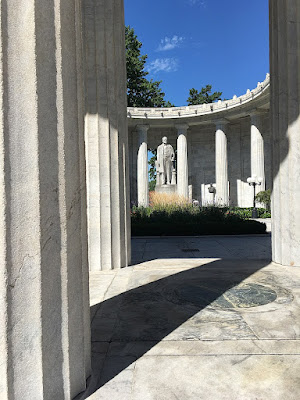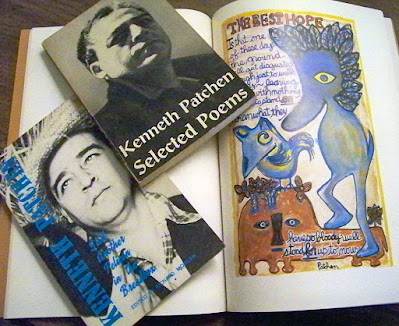In a room full of paintings by Claude Monet at the Art
Institute of Chicago in July, I was spoiled for choice. I turned and gazed,
focusing at first on the Waterloo Bridge and Charing Cross Bridge paintings in
which these two structures are obscured by the fog and haze Monet loved to
paint (see earlier post). In Waterloo Bridge, Gray Weather, for example,
smoke can be seen pouring into the air in the background, and the whole urban riverscape
lies beneath a hazy, blurry sky. These London paintings give credence to the thesis
of the two climate scientists who argued in a recent study that air pollution
"provided a creative impulse" for Monet.
After a while, because there were more than thirty people
in the room and most of them seemed to want to take a picture of whichever
canvas I was standing in front of, I turned away from the London paintings to
look at something more serene, three water lily paintings. In 1893 Monet bought
property in Giverny in France where he turned previously marshy ground into a
pond, built a Japanese-style bridge over it, and brought in some water lilies.
This garden became the subject of most of his later paintings, with a
particular focus on the water lilies.
Water Lily Pond 1900 depicts
lush vegetation and is enlivened by the curve of a dark bridge. Swirling masses
of water lilies fill the pond, and in the foreground, we can see reflections of
trees and other greenery on the banks. Water Lilies 1906 is more abstract
and simply shows a few graceful islands of vegetation floating in water that
reflects the sky and nearby trees. According to the Art Institute website, as
time went on, Monet became less concerned with "conventional pictorial
space," and so there is no horizon line. The same can be said of Water
Lily Pond 1917/19 in which a somewhat muddy palette of green, pink, purple,
white, gray and orange gives depth to the water and allows grassy shapes and
shadows to build around a central mass of reflections. Monet’s water lily
paintings, according to the Art Institute’s signage, was a “significant part of
the inspiration for the abstract artists who flourished later in the twentieth century.” I stood there a long time, taking in this third painting, emerging myself
in its somewhat mysterious depths.
Later, at the home of our friends Kathy and Richard in Youngstown, I had a chance to see real water lilies growing in the pond that graces one edge of their garden. The garden is full of herbs, grasses and flowers and is also decorated with small outdoor sculptures, including a few by Akron-based artist Don Drumm. In addition, gazing balls and kinetic wind sculptures give the whole yard a playful and dynamic quality, and when we sat near the pond, we could see frogs hopping onto and among the water lilies. Often there were pink flowers within the masses of the large, round, glossy leaves. But one thing about the water lilies themselves was that their charm and beauty didn’t really call to mind Monet’s canvases. One difference, of course, is that they may have been of different species, but more importantly, Monet's later works were too abstract, too focused on irregular masses of vegetation and reflections in the water to give any real sense of what water lilies are like. Well and good. The master painter shows us the world as he chooses. But there may have been more to it than that.
According to Dr. Michael F. Marmor, during the years in
which Monet was painting in his garden at Giverny, his vision was progressively
affected by cataracts. By the mid-1910s, Monet said that "…colors no longer
had the same intensity for me," and he began to trust the labels on tubes
of paint rather than his own vision. By the early 1920s, Monet thought he might
have to stop painting altogether, and he was aware that he couldn't really
discriminate color. His work at that time appeared increasingly abstract,
though there was nothing in his correspondence to suggest that he was being
influenced by the abstract painters of the early 20th century.
Because there is
good historical documentation of Monet's progressive vision loss due to
cataracts, we can assume that the changes in his painting style may have been
affected by his eye problems. Speaking as an ophthalmologist and not
an art critic, Dr. Marmor is careful to add that we can’t make these kinds of
judgements about every work of art we see. "It would be presumptuous,” he
says, “to assume that nonrepresentational painting implies poor visual acuity
or that painting with strong colors (or a lack of color) implies that the
artist has cataract or color vision abnormalities." Yes, of course! But it’s
a documented fact that Monet's work darkened and became more abstract as his
cataracts worsened, which makes it all the more intriguing that, though these
late paintings were not particularly influential during Monet’s lifetime, they
had a tremendous impact on future directions in the visual arts, especially
here in the United States.
Writing in The Brooklyn Rail, art historian and
critic Norman Kleeblatt reviewed a 2018 exhibit at l'Orangerie in Paris that purported
to show the affects Monet's later work had on the American art scene in the
mid-twentieth century. He says that the advocacy of the American Abstract
Expressionists helped to bring attention to Monet's later painting, which is why the Paris exhibit displayed Monet's late works next to paintings by American artists who
were influenced by it. Kleeblatt says that, at one and the same time, "...
late Monet could be explained and exploited as foreshadowing the origins of the
large-scale gestural canvases, close chromatic range, and all-over compositions
of the American painters." These late Monet's were often dismissed for
just these reasons -- "their narrow range of dark color, and seemingly
direct depiction of the natural world" seemed "either too romantic or
too Symbolist." Or worse, they were disparaged as the work of an artist
who had cataracts and very blurred vision. But, Kleeblatt tells us, Monet’s influence
was strong enough in the mid-twentieth century that two painter/critics began to call the work of their peers Abstract Impressionism.
The exhibit also strengthened the connection by showing a
film of Jackson Pollock dripping paint on canvas “alongside a film of a white-suited Monet painting on an easel in his
celebrated garden.” This was likely to be the short film available online today, which shows Monet in 1915 as an assured and masterful painter, looking
relaxed in his white suit. He can be seen holding his palette, making
thoughtful strokes with his brush and referring frequently to the nearby pond where
there are, recognizably, water lilies growing. We can't really follow his
progress on the canvas, but when the camera pulls back, we can see how lush and
filled with foliage his garden was.
Now back to Ohio where we not only spent time in our friends’ garden, but also stayed again in their Mid-century Modern house, with its eclectic mix of vintage furniture and other well-chosen items. Framed posters, photos and works of art abound, but new this year was an untitled work by Youngstown artist Al Bright. I was especially excited to get to know it, because it was mine, a gift from Kathy because I really enjoy Bright’s work. During our stay, I went from time to time to gaze at it, pleased by its palette of pale honeyed beige tones, with a bit of brown, gray and white in the lower half of the canvas, and more yellow tones in the upper half. There are strong horizontal brush strokes, and nearly in the middle of that upper lighter space, there's a semi-circle that looks like a setting sun cut off by a bank of clouds.
In a description on the website of the Butler Institute of American Art about a recent show featuring eight of Bright's works, he is described as "an artist who truly understood the handling of paint" and as a "remarkable colorist." Bright died in 2019, but there are a number of videos online in which you can watch him painting to live jazz. In each we see the work of a strongly gestural painter, an action painter. Watch him painting while Art Blakey and the Jazz Messengers are playing, and you can see the spontaneity of his work and its energy. His improvised art accompanies improvised music, and Bright can be seen to respond in a heartfelt way to the music that he hears.About her own work, Frankenthaler once said, "My pictures are full of climates, abstract climates, and not nature per se. But a feeling. And the feeling of an order that is associated more with nature." And this year, writing in The New Yorker about an exhibit of Frankenthaler’s work at Gagosian, Johanna Fateman has said that the artist’s canvases present “sweeping abstract vistas that recall the roar of waterfalls and crashing waves, as well as silent deserts.” Both Frankenthaler’s and Fateman’s notions help me to express the feeling my untitled Al Bright canvas elicits from me, with its predominance of sandy tones, reliance on horizontal lines and its hemicircle central shape that calls to mind a sun. The abstract vista it implies for me is a desert heatscape, the sun's energy pouring down on some monumentally barren place, calling to mind the planet Arrakis in Frank Herbert's Dune, calling to mind a future earth scorched by climate change. Not that, I think, Bright was ever a pessimistic artist, but this is something I find in this nearly monochrome work, and it gives me, as Frankenthaler says, a feeling of an order associated with nature. And that order is what happens when hot and dry are imposed by an intense and unforgiving sun as climate change proceeds apace.
Because this has been a summer of Canadian wildfires, it wasn’t a surprise that we experienced a day of smoky skies and dangerous levels of particulates when we were in Ohio. I’m no stranger to smoky haze over the Youngstown landscape because when I was growing up there the mills were still going strong. In fact, I remember that we accepted that smog and soot because the mills brought a certain kind of prosperity, just as Monet had a positive response to the smog and smoke he saw, which gave him a sense that the world was changing in dynamic and exciting ways. But on July 17, the smoky sky implied nothing but climate devastation and rather than being a harbinger of prosperity, it was a warning that humans need to change our ways soon or something that looks a lot like Al Bright's abstract vista may come to pass.












